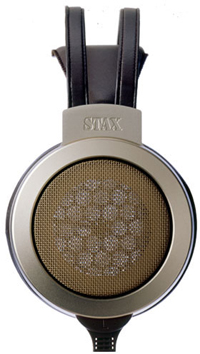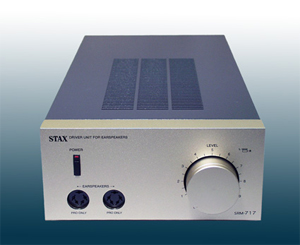You are reading the older HTML site
Positive Feedback ISSUE
12march/april 2004
stax
SR-007 Omega II/717 headphone system
as reviewed by Carlo Flores

CARLO FLORE'S SYSTEM: LOUDSPEAKERS ELECTRONICS SOURCES CABLES ACCESSORIES
|
The Stax Omega II System is visually striking—its champagne-tinted enclosure, with brown leather headband and ear cups, is so beautiful that even non-audiophiles know they are looking at something special. The Omega II places much distance between transducer and ear, and pictures don't capture the large size of these headphones. Still, they are extremely comfortable. I never noticed their weight, though as a circumaural design, they made my ears a bit hot. The Stax 717 Ear-Speaker Driver (Stax-speak for "amp") matches visually, though the tinted metal only graces the front, and the chassis is a dark gray matte color. Its features include two headphone jacks, separate left/right volume controls, an IEC receptacle, and a paralleled pair of inputs accommodating two sources, or one source with pass-through to another component (a preamp, for example). Stax uses proprietary termination, the cord for which is flat and wide but extremely flexible. Also included is a headphone carrying case. Technical information about the Omega II/717 system (and electrostatic headphones in general) is available from North American distributor Yamas Enterprises and, of course, Stax.
The folks at Yamas wrote me a letter, which closed: "I'll leave you to enjoy the splendor of the components." I enjoy arrogance in hi fi, and find this type of confidence amusing, but while my time with Stax has been favorable, I’ve had complaints. The Stax 303 headphones are interesting yet uninvolving, offering plenty of sound effects but not enough passion, though I've only heard them with Stax' SRM-T1 amplifier. The Signature 404s are very good headphones with the 717 amp, which transmits their aggressive sound quickly, but their high frequencies and noisy, cheaply made enclosure induce fatigue. In my system, I use the long-discontinued Stax SR-30s with the SRD-4 adapter, also known as the Electret-34 system. When they are powered by my Conrad-Johnson power amp, I enjoy them more than the Sennheiser HD580s with most headphone amps. When I read Yamas' letter, I laughed because I didn't yet realize that none of my previous Stax experiences mattered.
The transient response of the Omega II/717 is so immediate that "mind-blowing" doesn't describe it. The Omega IIs are not fast, since "fast" infers sped-up sound, exaggerated microdynamics, or trickery. Rather, they are unobtrusive, giving the recording a pace entirely its own. Microdynamics on Tricky's Maxinquaye were clear and focused. Where many headphone/amp combinations struggle, the Omega II/717 stayed composed and sounded as if it had more to give. The information on Radiohead's Kid A was laid bare. Windows opened and veils were removed, and the experience was special, with wicked synthetic beats and Thom Yorke's voice endearingly frail within the electronic effects. My foot was on the pulse of the recording. I'd like to call this a music lover's system, but it’s really an audiophile's wet dream.
Consider the DCC pressing of Joni Mitchell's Blue, with the greatest female singer of all time in her prime, framed by acoustic guitars in an intimate presentation. With such a simple recording, the Omega II/717 is stark and honest. Mitchell's voice takes its space, a little forward of the middle of my cranium. I close my eyes, focus, and she's naked—round, soft, and inviting— with nothing between us. The leading line is balanced, and the stage is not restricted by the headphones’ boundaries. I have only Joni. Oh, I can hear the rest—the guitar behind and to the side, the percussion—all of it outlined and identifiable. The space of the recording is there too, with realistic acoustics and decay, but I don't care about that because I have Joni, bare.

SRM-717 amplifier
I usually perceive reproduced music as having two parts: intimacy (punch, immediacy, and leading edge) and soundstage (instruments located in space, as well as the decay of sound). I've said, in another review, that the first comes naturally to headphones, and that the attempt to create soundstage yields headphones that sound detached. In the Omega II and 717, the soundstage is defined and extended. The Omega IIs dim the lights while performers take their space, and stay there. When I listen, I feel surrounded by music. It’s as common to hear a note come from behind my ear as it is to come from the side, or in front, or from the center of my head. Mind you, this doesn't sound forced at all, and the most impressive thing is the system's sense of scale. Distant sounds are perceived well beyond the physical location of the headphones, and the Stax system's ability to dig out the subtleties of the recording gracefully creates the illusion that low-level information is on a plane far away. Cymbals shimmer, rattle, and sound whole. The rasp of brushes sounds realistically diffused, their physical texture captured in sound. Then, when I choose, I pull away from the drum kit and listen to a performer. Right now it's Wes Montgomery, sitting oh so close. There is real depth here. Sounds aren't thrown, but emerge from the background. These headphones sound like littler, but more resolving Maggie 1.6QRs, with—and I can't emphasize this enough—deeper, faster bass. From headphones!
The foundation of the Omega IIs felt like it came from my core, resonating from within. Rich and full of impact, there seemed to be no limit to their extension—imagine my shock at feeling Jimmy Smith's pedals. I usually don’t care about anything lower than a double bass, since extension at the expense of speed sounds like shit. The Omega II reaches deeper depths more cleanly than all but the best speakers. I’m not kidding. This is extraordinary for headphones that sells for much less than many others. The system goes on forever, with a high treble that sounds completely effortless.
Nevertheless, when focusing on the lower treble/upper midrange, a wispy effect is apparent with some material. In contrast to the Joni Mitchell, Astrud Gilberto sounded soft and spaced out. The horns on Otis Redding's Otis Blue lacked bite and character. Could these headphones simply be accurately showing how flawed these recordings are? Maybe, because these traits were fleeting—there in one recording and gone from the next. Even when apparent, the effect wasn't startling so much as unusual. This is a characteristic I associate with some soft-sounding amps, though the Omega II/717 certainly doesn't sound soft. With the majority of recordings, it did not matter.
The Electrostatic vs. Dynamic argument is about as interesting as Solid State vs. Tubes, which is to say, not at all. Colored is colored, and it’s all colored, though maybe the Omega IIs aren’t. However, I need to broach this topic with respect to my midbass complaints. I'm a dynamics guy, always have been. The headphones I use to measure other headphones, the Grado HP-1s, may be familiar to some of you. For those who have not had the opportunity to hear them, don't draw any conclusions from the current Grado Labs. Through the HP-1s, I hear a presentation that sounds exactly like a headphone should—intimate yet aggressive with leading notes. Others have called the HP-1s bland, but I suspect they haven't heard them with a high current amp. Even when adequately powered, the HP-1s don’t have the depth of other headphones, but step into their stage and instruments are in a space relative to one another. These are headphones that invite the listener to listen closer, and that will forever be a part of my system.
On to midbass: The HP-1s create sharp, straight, leading lines without sounding shrill or fragile. At the same time, they have an almost thick presentation with certain material. Listening to The Who becomes listening to Entwistle, early Rolling Stones become Brian Jones. Tom Wait's piano? Dirty, seductive, sexy. A Wurlitzer is thick, juicy, oh so involving. With the first strike taking hold, I ride the reverb and fade away. The Omega IIs powered by the 717 have all this, even at times more in terms of information and speed, but without the leading line. I accepted that I am biased, but the Omega IIs don’t always draw me in. With The White Stripes' Elephant, you have the best sounding electric guitar of the past year. If I play that guitar through HP-1s, I melt in reverb and distortion. Meg White's drums are lazy and quaint, which only brings the guitar into sharper focus. I couldn't care less about Jack White's lyrics, because I'm too busy foot-tapping, rocking and rolling. It has been too many years since I’ve heard sound like Elephant’s from a modern recording. Play it through the Omega II/717, and the lazy drums are there, Jack is singing, but the guitar is missing something. There's no other way to put it, but for the detail/accuracy audiophile, the Omega IIs are king. There’s no other way to put that, either.
Doug Paratore (www.soundstage.com/allinyourhead) of Soundstage offered his reference amp while I had the Stax pieces in my possession. His amp is the KGSS, designed by Dr. Kevin Gilmore (http://gilmore.chem.northwestern.edu, contact Doug for information). I was desperate to hear the Omega IIs with a different amp, especially one that sells for approximately the same price as the 717, to isolate their character. Surprisingly, the incredible extremes, the lack of identifiable sound, the resolution, and the transient response stayed constant. All this I give to the Omega IIs, yet the two amps sound drastically different. The KGSS eliminated most of my midbass complaints. It sounded dramatically blacker and more linear than the 717. Resolution wasn’t better, but the KGSS allowed details to pop in the digital black and fade away quickly. Stereolab’s ABC Music sounded like heaven. Bass guitar wasn’t as diffused as it was with the 717. The presentation was tighter, and the sound closer to what I expect from headphones as opposed to speakers. The Omega IIs with the 717 have an expansive soundstage, in which performers take another step back. The 717’s reproduction of acoustics will make it the choice for many. I’d take the KGSS, but you already know my bias.
Take away that bias, and maybe it doesn't get any better than the Omega II and 717. They are sexy and throaty when the recording allows, and spatially expansive, with frequency extension to the heavens and depths. Other headphones, including the HP-1s, give only a hint of what the Omega IIs are capable. Over my time in hi fi, I've drifted from a focus on soundstage (when my listening was completely speaker-based) to an emphasis on drive and microdynamics (now, when I'm primarily headphone-based). The Omega IIs, when coupled to the 717, create a system that holds up to the best I've heard. Carlo Flores
Stax
SR-007
Omega II/717 system
Retail: $5750
US
Distributor
Yamas
Enterprises
web address: www.yamasinc.com
Stax
web address: http://www.stax.co.jp
